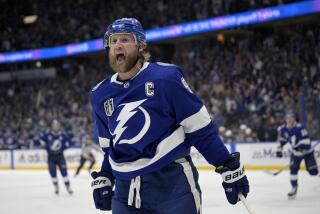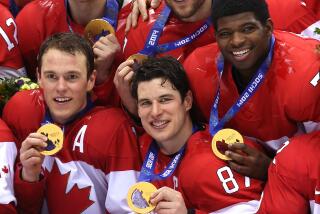Tough Days Ahead for NHL
ST. PAUL, Minn. — It’s debated between bites of hors d’oeuvres at parties, discussed in locker rooms, whispered about in corridors.
With the labor agreement involving the NHL and the players’ association due to expire Sept. 15 and the principals painting dramatically different pictures of how to achieve a sane and solvent future, are these the last days of the NHL as we know it?
The All-Star game is usually an occasion for fun and self-congratulation, but the buildup to today’s game at the Xcel Energy Center has been subdued.
Scoring is down, to about five goals a game. TV ratings are abysmal. Empty seats abound not only in new Sunbelt cities but in Boston and Chicago, “Original Six” standard-bearers. ABC/ESPN, nearing the end a five-year, $600-million TV deal with the NHL, will renew for only one season and at half the current average, according to sources familiar with the talks. It will show a handful of games on ESPN and none on ABC, blows to the NHL’s prestige and its bottom line.
“You’re going to have Armageddon with the expected labor impasse,” said David Carter, a sports business consultant who teaches at USC. “You’re going to see corporate sponsors walking away for good.”
Commissioner Gary Bettman insists the NHL can no longer spend 76% of revenues on player costs and says the union accepted its calculations. However, NHLPA Executive Director Bob Goodenow said after the union examined voluntary and unaudited financial reports of four teams -- known to be the Kings, Sabres, Canadiens and Bruins -- it found they had understated more than $50 million in revenues, easily done by directing money to related companies.
“Owners have told us they want a football-style hard cap,” Goodenow said. “We’re not prepared to negotiate a cap system.... It sets the stage for what will be very contentious negotiations.”
Bettman says he’s not seeking a cap, just a system that will allow big- and small-market clubs to be competitive and profitable. “I fear more for the future if we continue the way we are than anything else that might happen to fix the problem,” he said Saturday. “It has to be fixed. I think the owners are more prepared [for a lockout] and the league as a league is more prepared because it has to be.”
In the last labor dispute, the NHL locked players out for 103 days. That cut the 1994-95 season to 48 games and killed momentum gained when the glamorous, big-market New York Rangers won their first Stanley Cup championship in 54 years. Attendance rebounded, but that might not happen again, given the rise of extreme sports and other diversions.
Nonetheless, Bettman has told owners that it was worth suffering short-term pain to wring long-term economic concessions from players.
“I’d say our ownership would view it as difficult to carry on without a change,” said Kevin Lowe, general manager of the Edmonton Oilers. “[Bettman] said he’s committed to getting a system that will work in 30 markets, and that’s what you want to have. You don’t want the perception, whether rightly or not, of a competitive imbalance....
“There’s a feeling among hockey fans over the last decade that it’s tough for the small-market teams to be competitive. It’s not as exaggerated as in baseball, but it’s getting there.”
Said Roy Mlakar, president of the Ottawa Senators: “The way I always put it is this: We look forward to the day that we can be like the Green Bay Packers and play on an even field with the New York football Giants.”
The last substantive talks occurred on Oct. 1, when the NHLPA said it would take a 5% salary cut, adopt a luxury tax system and cut entry-level salaries, “a very, very, very significant proposal on our part,” Goodenow said. Bettman responded with a one-page statement that included an ideal average payroll of $31 million. NHLPA representatives walked out.
“As players, we’re going to do everything we can to get something done,” said Canuck center Trevor Linden, the NHLPA’s president, “but there’s only so far we’re going to go.”
Even accounting for rhetoric and public posturing, the outlook is bleak. The NHLPA has told members they might be out of work for 18 months.
“We have players who are living the last two years way below their means in anticipation of a lockout,” said Allan Walsh, an agent with the Beverly Hills Sports Council.
Mighty Duck captain Steve Rucchin said he hoped for the best but was primed for the worst. “It’s definitely in the back of our minds right now,” he said. “We’d all like to play the game. We’re also ready to not be playing. Hopefully, it doesn’t happen. I think every player is more prepared for it, much more so than for the last one, which kind of surprised everyone.”
The NHL began gearing up in 1998, when the Board of Governors asked each club to pay $30 million into a fund needy brethren can tap during a lockout. General managers began signing players to short contracts or timing deals to end after this season. The contracts of 14 Red Wings -- including Nicklas Lidstrom, Kris Draper, Mathieu Schneider, Tomas Holmstrom, Brett Hull, Steve Yzerman, Chris Chelios and Dominik Hasek -- end June 30. Colorado has six players under contract for next season, Minnesota fewer than 10. More than 230 players might be free agents.
“We want financial flexibility, no matter what the system,” said Ken Holland, Detroit’s general manager. “We have lots of players whose contracts expire, and we have a lot of other kids we feel can step in.”
The NHL claims its teams lost $300 million last season, a sum Forbes magazine put at $123 million. The league says revenues have risen 163% over the last nine seasons -- including one under the old labor deal and the truncated 1994-95 season -- while player costs rose 252%. The NHLPA contends those increases are 157% and 170%, respectively, since 1995-96, the first full season under the new agreement.
“I’ve talked to a couple of owners, and it doesn’t sound good,” said ABC announcer Al Michaels, an avid hockey fan and King season-ticket holder. “Maybe they’re overstating the case on the owners’ end, but it sounds like they’re resolved to get their financial house in order.
“It sounds like there will be no season next year.”
Another looming problem is the TV deal. At $600 million for five years, it’s paltry compared to the NFL’s $17.6-billion TV revenues, the NBA’s $4.7 billion, Major League Baseball’s $3.35-billion haul and NASCAR’s $2.8-billion income, but it’s the best the NHL ever had. Halving it would slash each team’s cut from $4 million to $2 million, “and that’s not going to pay for a backup goaltender,” Carter said. “If you’re looking to invest in the sport, and I’m talking about broadcasters, fans and sponsors, if you appear on shaky ground, it might just be a self-fulfilling prophecy....
“I can’t think of another profession where 70% of the company’s income goes directly to the employees. It’s not a stable business model. It doesn’t work.”
ESPN began airing some NHL games in 1979 and got national broadcast rights in 1984. It lost the rights to SportsChannel in 1988 but regained them in 1992. When it launched ESPN2 in October 1993, it welcomed the NHL as a programming staple.
However, it has given the NHL lower priority since it acquired a share of NBA TV rights before last season. ESPN cut its NHL slate from 27 regular-season telecasts to 21 last season and 20 this season. ESPN2 went from 75 telecasts in 2001-02 to 50 last season and 50 this season.
Like Fox, which invested millions of dollars in technological innovations such as the glowing puck during its five-year hold on NHL TV rights, ABC/ESPN has tried many experiments that cater to fans. It has deployed cameras in nets, on top of referees’ heads and in arena rafters and allowed viewers to choose which game they’ll see, but it has gotten few ratings rewards.
“For the NHL, their salvation would be to find another broadcast entity that will come up with big money, but I don’t see that in this environment,” Michaels said. “It’s so funny, and I’m not saying anything you haven’t heard before, but it’s really a shame hockey doesn’t translate well to TV. I think it’s the best sport to watch in person, and over the years I’ve taken probably 25 people to their first game, and they’ve said the same thing. People say hockey has to learn to do [telecasts] better, but I’m not sure you can.”
The league has touted HDTV as an enhancement, but Michaels, who has seen it, said it’s not “the cure-all.” He believes the NHL’s problems lie elsewhere, in overly ambitious expansion and players who are hidden behind helmets and voluminous equipment, making it tough for fans to identify and bond with them.
“I think part of it is the game itself. It’s reached the point where scoring is too low,” he said. “I don’t want to see 7-6 games. I’m a real fan. But I don’t want all the 1-0 and 2-1 games. And maybe overtime needs to be tweaked. There are still too many games that end in ties.”
If all that weren’t enough, the NHL also faces a challenge from the World Hockey Assn., which plans to begin play this fall with six to 10 teams. Its commissioner, Bobby Hull, plans to achieve financial stability with a salary cap and lure families by keeping tickets prices reasonable.
“We’re losing a group of children each year to other sports because their parents can’t afford to take them,” said Hull, who’s counting on a boost from an NHL lockout.
To him, the NHL’s problems are self-inflicted. “They went wrong by offering these kids so much money, and by teams trying to buy the Stanley Cup and trying to buy winning franchises,” he said. “You don’t pay kids those kinds of dollars off the bat. You’ve got to give them incentive to play better. They don’t have that now. It’s like the tail wagging the dog. The NHLPA runs the league. If some of these kids weren’t playing hockey they’d be out picking you-know-what with the chickens.
“That’s where it’s all come to rest. The owners are spending their fathers’ and grandfathers’ money to buy franchises and to buy wins, but you have to draft carefully and develop players and put together a team carefully.”
Carter, the sports business consultant, sees no quick fix. “You do have to have cost certainty,” he said, “but maybe if there’s a protracted labor impasse, maybe you lose some unhealthy franchises. Maybe it will be survival of the fittest.”
Ron Salcer, an agent whose clients include Ed Belfour, Rob Blake and Marian Gaborik, said he hoped the NHL could survive without contracting. “They have to figure out how to make this work,” he said. “To me, hockey is entertainment. This isn’t the NHL vs. the NHLPA. It’s for all the other entertainment options and dollars out there.”
*
Times staff writer Chris Foster contributed to this report. Teaford reported from Los Angeles.
*
(BEGIN TEXT OF INFOBOX)
A Look at the Numbers
SALARIES
Average league salary, with % increase over prior season
*--* 1994-95 $730,000 1995-96 $890,000 21.8% 1996-97 $980,000 10.3% 1997-98 $1,170,000 18.6% 1998-99 $1,290,000 10.4% 1999-2000 $1,360,000 5.2% 2000-01 $1,430,000 5.8% 2001-02 $1,640,000 14.5% 2002-03 $1,790,000 9.0%
*--*
Source: NHL
TV RATINGS
Fox
1995: 2.0 rating regular season, no All-Star game (canceled by lockout), 1.9 rating playoffs.
1996: 2.1 rating regular season, 4.1 All-Star game, 2.4 playoffs.
1997:1.9 regular season, 2.8 All-Star game, 2.1 playoffs.
1998:1.4 regular season, 2.7 All-Star game, 1.8 playoffs
1999: 1.4 regular season, 2.2 All-Star game, 1.5 playoffs.
Source: Fox
ESPN
2002-03: 8 telecasts 0.56 rating, 484,421 homes
2003-04: 7 telecasts 0.50 rating, 440,320 homes
ESPN2
2002-03: 35 telecasts 0.23 rating, 192,201 homes
2003-04: 34 telecasts 0.22 rating, 188,107 homes
Source: ESPN
ABC (regular season)
2000: 1.3 rating, 4 share
2001:1.1 rating, 3 share
2002:1.4 rating, 4 share
2003:1.1 rating, 3 share
ABC (Stanley Cup Finals)
2000: (four games) 3.7 rating, 8 share.
2001: (five games) 3.3 rating, 6 share.
2002: (three games) 3.6 rating, 7 share.
2003: (five games) 2.9 rating, 5 share.
More to Read
Go beyond the scoreboard
Get the latest on L.A.'s teams in the daily Sports Report newsletter.
You may occasionally receive promotional content from the Los Angeles Times.







